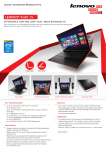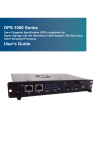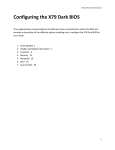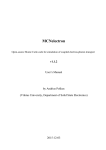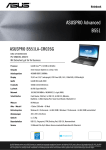Download Intel I7-4800mq User's Manual
Transcript
Overclocking Unlocked Intel®
Core™ Processors for High
Performance Gaming and
Content Creation
Michael Moen – Sr. System Engineer, Intel Corporation
Dan Ragland – Sr. System Engineer, Intel Corporation
JJ Guerrero – Sr. Technical Marketing Specialist, Asus
AIOS001
1
Agenda
•
•
•
•
•
•
2
Overclocking Theory and Trends
High-end Desktop Overclocking Architecture
Overclocking Design Tips
Desktop and Mobile Overclocking Architecture
Harnessing Overclocking
Summary
Risk Reminder
WARNING: Altering clock frequency and/or voltage
may: (i) reduce system stability and useful life of the
system and processor; (ii) cause the processor and other
system components to fail; (iii) cause reductions in system
performance; (iv) cause additional heat or other damage; and
(v) affect system data integrity. Intel has not tested, and does
not warranty, the operation of the processor beyond its
specifications. Intel assumes no responsibility that the
processor, including if used with altered clock frequencies
and/or voltages, will be fit for any particular purpose. For more
information, visit:
http://www.intel.com/consumer/game/gaming-power.htm
3
Agenda
•
•
•
•
•
•
4
Overclocking Theory and Trends
High-end Desktop Overclocking Architecture
Overclocking Design Tips
Desktop and Mobile Overclocking Architecture
Harnessing Overclocking
Summary
Defining Overclocking
• What is Overclocking (OC)?
– The process of increasing clock rates beyond
specification
• Why Overclock?
– Increase performance for compute intensive tasks,
e.g., transcode, gaming, rendering
– Compete, Promote, Socialize
• How is this done?
– Obtain a motherboard optimized for Intel® unlocked
processors
– Change unlocked ratios or platform clock frequency
– Increase voltage on relevant interfaces
– Improve cooling on overclocked/overvoltaged
components
5
Overclocking Theory
General Principles
The Rule: Maximize frequency, minimize voltage/current and
maximize heat dissipation to meet personal stability requirements
Benefits
How
Processor
Cores
Rendering, Music, Photo
and Video editing,
Transcode, Gaming
Physics, AI, Compute
Intensive
Increase Power Limits and Max
Current
Raise Core voltage
Increase active Core ratios
Processor
Integrated
Graphics
(pGfx) †
Gaming frame rates,
Media Transcode
Increase Power Limits and Max
Current
Raise pGfx voltage
Raise pGfx max ratio
Memory
Processor Graphics
performance,
Sound engineering, Photo
and Video editing
Platform
Base Clock
All of the above
Increase all domain voltages
Reduce weakest domain
frequency via ratios
† pGfx utilizes Intel® Iris™ Pro., Intel® Iris , or Intel® HD Graphics
6
Increase memory ratio
Raise memory IO voltage
Change timings
Increase system agent voltage
Increasing Complexity
What
Observed Frequency Trends in OC
Q: How much OC can I expect from my CPU?
A: There are many factors
– Every CPU is designed to meet nominal requirements with
intentional guardband – not specifically for OC
– Overclocking is the act of tapping into the intentional guardband
+ design conservatism + Si process conservatism
– This changes with each CPU process stepping, architecture change
and overall design targets
HEDT = High End Desktop. Today this includes Socket LGA2011.
This data was collected from overclocking forums and should be considered approximate for illustrative purposes only.
7
Agenda
•
•
•
•
•
•
8
Overclocking Theory and Trends
High-end Desktop Overclocking Architecture
Overclocking Design Tips
Desktop and Mobile Overclocking Architecture
Harnessing Overclocking
Summary
Intel® Core™ i7 Desktop Processors Based on
Socket LGA2011 with Intel® X79 Express Chipset
C
Processor
1
2
3
4
5
6
Memory
DMICLK
– Unlocked Intel® Turbo Boost
Technology limits†
– Unlocked core ratios up to 63 in
100MHz increments†
– Programmable voltage offset
M Memory
C
PCIE
P
PEG
D
DMI
• Core Frequency
M
• Memory Ratio
– Unlocked memory controller
– Granularity in 266MHz steps
– Ratios supported up to 2400Hz
• DMICLK (aka BCLK)
R
DMI
R
×1
– Fine Grain range ± 5-7%
– BCLK ratios = 1.0, 1.25, 1.67
• PEG and DMI Ratios
P
DB1200
~
CK505
D
– PEG/DMI ratios = 80/50, 64/40,
48/30
– Ratio option must reflect selected
BCLK coarse ratio
Example : Core Freq x 1.25 R requires PEG/DMI ratios
at 64/40 x 1.25 R to keep at 8 GHz/5 GHz nominal
9
† Only some processors enable part or all of these features. Consult processor documentation for details.
P
D
Intel® Core™ i7 Desktop Processors Based on
Socket LGA2011 with Intel® X79 Express Chipset
Feature Overview
SKU
i7-4960X
i7-4930K
i7-4820K
6/15M
6/12M
4/10M
Up to 63
Up to 63
Up to 63
PL1, PL2, Tau, ICCMax Overrides
√
√
√
Real-time Core Overclocking (in
OS)
Yes
Yes
Yes
Up to 2400
Up to 2400
Up to 2400
√
√
√
Cores/Cache
Turbo Ratio Overrides (100MHz
Steps)†
DDR Frequency Overrides
(266MHz Steps)
DDR Timing Overrides
Coarse BCLK Ratios supported
with PEG, DMI ratios
Enhanced Ratio Enhanced Ratio
Support (1.0,
Support (1.0,
1.25, 1.67)
1.25, 1.67)
† Memory ratio not fuse limited, but support above 2400 via ratio not
guaranteed. Use BCLK for higher frequencies.
10
Enhanced Ratio
Support (1.0,
1.25, 1.67)
Agenda
•
•
•
•
•
•
11
Overclocking Theory and Trends
High-end Desktop Overclocking Architecture
Overclocking Design Tips
Desktop and Mobile Overclocking Architecture
Harnessing Overclocking
Summary
Overclocking Design Tips
What board designers consider for unlocked
Processors
COLLABORATION
Work closely with Intel to understand the platform architecture and gauge
hardware requirements. This helps to define customized overclocking
options for different segments.
POWER DESIGN
Ensuring that onboard power delivery circuitry is capable of exceeding
processor power requirements under extreme loading conditions.
CIRCUITRY DESIGN
Tuning of trace layouts and platform microcode to extend overclocking
headroom for CPU and DRAM.
CUSTOM SETUP
Utilize customized hardware to mitigate platform overclocking obstacles.
PRODUCT DEVELOPMENT
Develop software and hardware solutions to provide automated overclocking
features.
12
These recommendations are the sole opinion of an expert overclocker based on experience. Intel does not endorse or support these recommendations. Intel
has not tested, and does not warranty, the operation of the processor beyond its specifications
Overclocking Design Tips
How enthusiast board/system designs
influence overclockability
• High Quality Components
−
−
−
−
−
Long-life solid polymer & MLCC Capacitors
High current MOSFETs
Low DCR inductors
Advanced digital buck controllers
More copper in power plane
• Efficient Cooling Through Layout Design
• Careful Analysis of Signal Integrity:
− Tight control of trace impedance on PCB, more
layers, shorter lengths & length matching
− Tuning of MRC to improve signal margins and
memory compatibility
• Dedicated hardware and software solutions:
− Hardware and software features that allow realtime changes to overclocking parameters and
improve system stability for smooth overclocking
experience
• Intuitive UEFI
13
− Intuitive layout with customizable menus,
overclocking profiles (presets and user configured)
and extensive auto-rules for all parameters
− OC recovery with low-level UEFI flashing
capabilities
Live Demo:
Optimization of Core, Memory and
BCLK to achieve visibly better
performance experience on
content creation with a Intel®
Core™ i7-4960X Extreme Edition
Processor
14
Agenda
•
•
•
•
•
•
15
Overclocking Theory and Trends
High-end Desktop Overclocking Architecture
Overclocking Design Tips
Desktop and Mobile Overclocking Architecture
Harnessing Overclocking
Summary
Next Generation Intel Haswell Microarchitecture
×C
CPU
1
– Unlocked Intel® Turbo Boost
Technology limits†
– Unlocked core ratios up to 80 in
100MHz increments†
– Programmable voltage via iVR
Memory
2
×M Memory
×C
3
4
×G
PCIe*
pGfx
DMICLK
– Unlocked graphics ratios up to 60 in
50MHz increments
– Programmable voltage via iVR
×D DMI
×M
DMICLK/BCLK
• Memory Ratio
– Unlocked memory controller
– Options for 200 and 266MHz steps †
– Logical ratios up to 2933MHz†
DMI
×D
OC
BCLK
Non-OC
100MHz
• Graphics Frequency (pGfx)
– Unlocked Intel® HD Graphics limits†
×P PEG
×G
• Core Frequency
• DMICLK (aka BCLK)
– Unlocked PCH clock controller (1MHz
increments upwards of 200MHz)†
PCIe
×P
×D
• PEG and DMI Ratios
– Variable ratios (must reflect selected
BCLK frequency)†
16
PCIe = PCI Express*
† Only some processors enable part or all of these features.
OC VR Design on Legacy Platforms
VCORE
VGFX
VPLL
CPU
VSA
VIO
External VRs
External VRs
• In current generation platforms, CPU VRs are on the
motherboard
• Often, a separate VR exists for each rail to the CPU
• Voltage margining is accomplished using platform VRs
4th Generation Intel ® Core™ processor
changes this dramatically with integrated
voltage regulation
17
Next Generation Intel Haswell Microarchitecture
Voltage Planes for Performance Tuning
DDR
Core
VCCIN
iVR
Last Level Cache
Ring
Cores
Ring
pGfx
pGfx
IOA,IOD
System
Agent
1.5V Nom
for DDR3
•
<=1.65V
for XMP
•
1.35V
Nom for
DDR3L
•
VSA, VIOA,
VIOD: Up
to 500mV
Offset V
from
nominal
DMI
•
VCCIN: SVID 1.8V Nom up to 2.3V+, static V up to 3.04V
•
VCORE: dynamic additional V, static V up to 2.0 V
•
VRING: dynamic additional V, static V up to 2.0 V
•
VGT: dynamic additional V, static V up to 2.0 V
PCIe* = PCI Express*
•
PCIe*
SA
18
VDDQ
Next Generation Intel Haswell Microarchitecture
Voltage Override Modes
XE
turbo
non-turbo
•
Interpolation
(adaptive) in the
overclocking
region
•
Override applied
to the entire
curve.
Important for
extreme OC.
volts
volts
XE
XE
turbo
Override V/f
non-turbo
Offset V/f
freq
19
XE
turbo
freq
turbo
Positive /
Negative offset
applied to the
entire curve.
Important for
mainstream
overclocking.
freq
non-turbo
•
Default V/f curve
(SVID operation)
volts
•
Interpolation V/f
volts
non-turbo
Fused V/f
freq
iVR provides flexibility consistent with all
margining modes generally supported by
19
current
generation external VR designs
Next Generation Intel Haswell Microarchitecture
Clock Tree
BCLK @100, 125 or 167
MHz +/1 5-7%
DDR
•
Single BCLK input comes
from PCH in <1MHz steps
•
Acceptable input to CPU
limited by PIC Express*
(PCIe) and DMI PLL interface:
Cores
Cache
Ring
Last Level
100MHz x ±5-7% PEG/DMI @ 5:5
Agent
PCIe*
DMI
pGfx
125MHz x ±5-7% PEG/DMI @ 5:4
System
167MHz x ±5-7% PEG/DMI @ 5:3
•
Frequency Relationships
f(GT) = BCLK/2*GT Ratio
f(Core) = BCLK*Core Ratio
f(Ring) = BCLK*Ring Ratio
f(DDR) = BCLK*1.33*DDR Ratio
-Orf(DDR) = BCLK*1.00*DDR Ratio
20
Enhanced BCLK Capabilities
Key Differences Between Generations
Intel® Core™ i7
processors on
LGA2011
Coarse
Adjustment
Fine
Range Peak
Observed †
3rd Gen Intel Core
processors on
LGA1155
Next Gen Intel
Haswell
Microarchitecture
BCLK multipliers
{1.0,1.25,1.67} input
to CPU
CPU adjusts PEG/DMI
ratios {5:5,5:4,5:3}
based on BCLK multi
None
Select CPU PEG/DMI
ratios of {5:5,5:4,5:3}
depending on what
clock frequency you
request from PCH
External clock device
output adjustment ± 57% over nominal
100MHz
PCH output
adjustment ± 5-7%
over nominal 100MHz
PCH output ± 5-7%
around frequency
points 100MHz,
125MHz, 167MHz
168 MHz
(non-continuous)
116.95 MHz
>167 MHz
(non-continuous)
4th Generation Intel Core processors deliver BCLK
overclocking experience consistent with current
generation high-end platforms based on LGA2011
† This data was collected from overclocking forums and should be considered approximate for illustrative purposes only.
21
Next Generation Intel Haswell Microarchitecture
Available Performance Tuning Ratios
Core
Turbo
Ratios†
DDR
Core ratios up
to 80
•
Unlocked Turbo
Limits
•
Current Limit
Override
•
Graphics ratios
up to 60
pGfx
Ratios†
22
PCIe* = PCI Express*
Cores
System
Last Level Cache
PCIe*
Agent
Ring
•
PEG, DMI
Ratios
DDR Ratios
DMI
•
266MHz Steps
up to 2933MHz
•
200MHz steps
up to 2800MHz
•
Timing
Overrides
•
Manual or can
be automated
through XMP
1.3
PEG
DMI
Ratios
pGfx
•
BIOS sets based on requested BCLK f
•
100MHz: 80/50
•
125MHz: 64/40
•
167MHz: 48/30
(PEG/DMI Ratios)
† = Changeable at OS Level
Ring
Ratios†
•
Ring Ratios up
to 80
•
Ring Ratio
typically <=
Core or GT
Desktop: 4th Generation Intel® Core™ i7/i5
Processors Based on Socket LGA 1150
Intel® Z87 Express Chipset
Unlocked “K”
Intel H87 Express Chipset
†Others
Unlocked
Processors:
Turbo Ratio Overrides
√
DDR Frequency Overrides
√
√
Fine BCLK Overrides
√1
√1
Intel® Core™ i7
Processors
4770K
Coarse BCLK Ratios
√2
iVR Overvoltage
√
√
Intel Core i5
Processors
4670K
PL1, PL2, Tau, ICCMax Overrides
√
√
† This includes Intel Core i3, Intel®
Pentium™, and Intel® Celeron™
1
23
DDR Timing Overrides
√
√
pGfx Ratio Overrides
√
√
•
•
•
•
Actual Fine BCLK frequency adjustments
will be limited. ~5%
2
Coarse BCLK Ratios (1.0, 1.25, 1.67)
are unlocked with K SKU processors only
Note: Actual overclocking results will vary
and capabilities are subject to change.
Turbo ratios and power, pGfx Ratios, iVR voltages are updateable real-time in OS
Fine BCLK, DDR timings are changeable real-time over very small range
Larger changes can be made with reset. BCLK range highly limited.
DDR Frequency requires reset
Mobile: 4th Generation Intel® Core™
Processor Overclocking†
Summary:
• Core overclocking on select Intel® Core™ i7 SKUs
• Graphics and memory overclocking on all Intel Core i7 and Core i5 based -H, -M, and -U series processors
Turbo
iVR OverBCLK
Ratio
voltage
Coarse(1)
Overrides
-H and
i7-4930MX
-M Series i7-4900MQ
i7-4950HQ
i7-4800MQ
i7-4850HQ
i7-4702MQ
i7-4700MQ
i7-4750HQ
i5
i3
DDR Ratio & Processor
Timing
Gfx Ratio
Overrides
Overrides
Unlimited
6 bins
6 bins
4 bins
4 bins
2 bins
2 bins
2 bins
None
None
Yes
Yes
Yes
Yes
Yes
Yes
Yes
Yes
No
No
Yes
Yes
No
Yes
No
Yes
Yes
No
No
No
Yes
Yes
Yes
Yes
Yes
Yes
Yes
Yes
Yes
No
Yes
Yes
Yes
Yes
Yes
Yes
Yes
Yes
Yes
No
Yes
Yes
Yes
Yes
Yes
Yes
Yes
Yes
Yes
No
-U Series
i7-4600U
i7-4650U
i7-4558U
i5
i3
4 bins
4 bins
4 bins
None
None
Yes
Yes
Yes
No
No
No
No
No
No
No
No
No
No
No
No
Yes
Yes
Yes
Yes
No
Yes
Yes
Yes
Yes
No
-Y Series
All
None
No
No
No
No
No
1
†
24
BCLK
Fine(1)
Requires Intel HM87 or QM87 chipsets and results will vary.
Actual overclocking results will vary and capabilities are subject to change.
Live Demo:
Mobile Overclocking using the
Intel® Core™ i7-4950HQ processor
in the Clevo W740SU Notebook
25
Agenda
•
•
•
•
•
•
26
Overclocking Theory and Trends
High-end Desktop Overclocking Architecture
Overclocking Design Tips
Desktop and Mobile Overclocking Architecture
Harnessing Overclocking
Summary
Intel® Extreme Memory Profile (Intel® XMP)
• Expansion of the standard DDR3 memory
specification. Enables speeds, latencies
outside of JEDEC Specification.
– Easy, robust, overclocking solution designed
to take advantage of the unlocked capability
of Intel® Core™ Processors
– Predefined and tested Intel XMP profiles can
be loaded via BIOS or a specific operating
system-level tuning application
Intel® XMP compliant DIMMs available
– Supports all Intel Core i7, i5 Processors †
– Corsair*, G.Skil*, Kingston*, Patriot*, Crucial*
and others
– XMP Ready: Module has been programmed
with an uncertified profile GOOD
– XMP Certified: Module has passed supplier
test and submission process for specific CPU
and motherboard BEST
– Certifications posted at:
System boots
with highest
supported
JEDEC defined
parameters by
default
Select XMP
profile via
enabled BIOS
or tuning app
and profile and
reset
http://www.intel.com/consumer/game/extreme-memory.htm
27
†CPU must support unlocked memory multiplier and be paired with
correct chipset. Intel XMP is overclocking
Intel® Extreme Tuning Utility (Intel® XTU)
• Simple-to-use
Windows*
application
• Exposes CPU and
PCH knobs for
performance
tuning by user
• Real-time
adjustment of key
settings without
rebooting1
• Version 4.2 now
available for
download from
Intel or other
motherboard
suppliers †
http://www.intel.com/go/xtu
†Motherboard BIOS must be configured correctly to work with XTU. Contact your motherboard supplier for more information.
1 Available select 3rd and 4th Generation Intel® Core™ Processor SKUs.
28
Intel® XTU and HWBot.org*
Combined Features
• Upload/Download overclocking
settings reliably
• Export/Import XTU overclocking
settings
• Compare benchmark scores and
configurations with others
• Link other benchmark scores to XTU
profiles
• Compete with others for higher
scores
• Integrated with existing social
networks: Facebook* and Twitter*
29
Live Demo:
Intel® Extreme Tuning Utility
v4.2 with AppTune Beta
Feature using a Intel® Core™
i7-4770K Processor
30
Live Demo:
SSD Overclocking Technology
31
Agenda
•
•
•
•
•
•
32
Overclocking Theory and Trends
High-end Desktop Overclocking Architecture
Overclocking Design Tips
Desktop and Mobile Overclocking Architecture
Harnessing Overclocking
Summary
Summary
• Intel® Core™ i7 Processors based on Socket LGA2011 offer
Core, DDR and BCLK overclocking experience on processors
with the highest core count and memory capacity
• Desktop and Mobile 4th Generation Intel Core processors offer
select SKUs with unlocked core, memory and graphics ratios
• Real-time overclocking offers an improved user experience for
content creation and gaming users
• The AppTune beta feature, in Intel® Extreme Tuning Utility v4.2,
is an exciting new way to tune system performance dynamically
and uniquely for each specific application
• Intel has not tested, and does not warranty, the operation of
the processor beyond its specifications
• For designers wanting to develop overclocking platforms,
documentation is available under NDA that details all tuning
knobs. Contact your Intel field representative.
33
Legal Disclaimer
INFORMATION IN THIS DOCUMENT IS PROVIDED IN CONNECTION WITH INTEL PRODUCTS. NO LICENSE, EXPRESS OR
IMPLIED, BY ESTOPPEL OR OTHERWISE, TO ANY INTELLECTUAL PROPERTY RIGHTS IS GRANTED BY THIS DOCUMENT. EXCEPT
AS PROVIDED IN INTEL'S TERMS AND CONDITIONS OF SALE FOR SUCH PRODUCTS, INTEL ASSUMES NO LIABILITY
WHATSOEVER AND INTEL DISCLAIMS ANY EXPRESS OR IMPLIED WARRANTY, RELATING TO SALE AND/OR USE OF INTEL
PRODUCTS INCLUDING LIABILITY OR WARRANTIES RELATING TO FITNESS FOR A PARTICULAR PURPOSE, MERCHANTABILITY,
OR INFRINGEMENT OF ANY PATENT, COPYRIGHT OR OTHER INTELLECTUAL PROPERTY RIGHT.
A "Mission Critical Application" is any application in which failure of the Intel Product could result, directly or indirectly, in
personal injury or death. SHOULD YOU PURCHASE OR USE INTEL'S PRODUCTS FOR ANY SUCH MISSION CRITICAL
APPLICATION, YOU SHALL INDEMNIFY AND HOLD INTEL AND ITS SUBSIDIARIES, SUBCONTRACTORS AND AFFILIATES, AND
THE DIRECTORS, OFFICERS, AND EMPLOYEES OF EACH, HARMLESS AGAINST ALL CLAIMS COSTS, DAMAGES, AND EXPENSES
AND REASONABLE ATTORNEYS' FEES ARISING OUT OF, DIRECTLY OR INDIRECTLY, ANY CLAIM OF PRODUCT LIABILITY,
PERSONAL INJURY, OR DEATH ARISING IN ANY WAY OUT OF SUCH MISSION CRITICAL APPLICATION, WHETHER OR NOT INTEL
OR ITS SUBCONTRACTOR WAS NEGLIGENT IN THE DESIGN, MANUFACTURE, OR WARNING OF THE INTEL PRODUCT OR ANY OF
ITS PARTS.
Intel may make changes to specifications and product descriptions at any time, without notice. Designers must not rely on the
absence or characteristics of any features or instructions marked "reserved" or "undefined". Intel reserves these for future
definition and shall have no responsibility whatsoever for conflicts or incompatibilities arising from future changes to them. The
information here is subject to change without notice. Do not finalize a design with this information.
The products described in this document may contain design defects or errors known as errata which may cause the product to
deviate from published specifications. Current characterized errata are available on request.
Contact your local Intel sales office or your distributor to obtain the latest specifications and before placing your product order.
Copies of documents which have an order number and are referenced in this document, or other Intel literature, may be
obtained by calling 1-800-548-4725, or go to: http://www.intel.com/design/literature.htm
Haswell and other code names featured are used internally within Intel to identify products that are in development and not yet
publicly announced for release. Customers, licensees and other third parties are not authorized by Intel to use code names in
advertising, promotion or marketing of any product or services and any such use of Intel's internal code names is at the sole
risk of the user.
Intel, Core, Look Inside and the Intel logo are trademarks of Intel Corporation in the United States and other countries.
*Other names and brands may be claimed as the property of others.
Copyright ©2013 Intel Corporation.
34
Legal Disclaimer
•
•
•
•
•
35
Overclocking Disclaimer WARNING: Altering clock frequency and/or voltage may: (i) reduce system stability and useful
life of the system and processor; (ii) cause the processor and other system components to fail; (iii) cause reductions in
system performance; (iv) cause additional heat or other damage; and (v) affect system data integrity. Intel has not
tested, and does not warranty, the operation of the processor beyond its specifications. Intel assumes no responsibility
that the processor, including if used with altered clock frequencies and/or voltages, will be fit for any particular purpose.
For more information, visit Overclocking Intel Processors.
Overclocked Memory Warning: Altering PC memory frequency and/or voltage may (i) reduce system stability and use
life of the system, memory and processor; (ii) cause the processor and other system components to fail; (iii) cause
reductions in system performance; (iv) cause additional heat or other damage; and (v) affect system data
integrity. Intel assumes no responsibility that the memory, included if used with altered clock frequencies and/or
voltages, will be fit for any particular purpose. Check with memory manufacturer for warranty and additional details.
Overspeed Protection Removed Warning: Altering clock frequency and/or voltage may (i) reduce system stability and
useful life of the system and processor; (ii) cause the processor and other system components to fail; (iii) cause
reductions in system performance; (iv) cause additional heat or other damage; and (v) affect system data
integrity. Intel has not tested, and does not warranty, the operation of the processor beyond its specifications.
Processor Numbering Notice: Intel processor numbers are not a measure of performance. Processor numbers
differentiate features within each processor family, not across different processor families: Go to:
Learn About Intel® Processor Numbers
Intel® Turbo Boost Technology requires a system with Intel Turbo Boost Technology. Intel Turbo Boost Technology and
Intel Turbo Boost Technology 2.0 are only available on select Intel® processors. Consult your PC
manufacturer. Performance varies depending on hardware, software, and system configuration. For more information,
visit http://www.intel.com/go/turbo.
Risk Factors
The above statements and any others in this document that refer to plans and expectations for the third quarter, the year and
the future are forward-looking statements that involve a number of risks and uncertainties. Words such as “anticipates,”
“expects,” “intends,” “plans,” “believes,” “seeks,” “estimates,” “may,” “will,” “should” and their variations identify forward-looking
statements. Statements that refer to or are based on projections, uncertain events or assumptions also identify forward-looking
statements. Many factors could affect Intel’s actual results, and variances from Intel’s current expectations regarding such factors
could cause actual results to differ materially from those expressed in these forward-looking statements. Intel presently considers
the following to be the important factors that could cause actual results to differ materially from the company’s expectations.
Demand could be different from Intel's expectations due to factors including changes in business and economic conditions;
customer acceptance of Intel’s and competitors’ products; supply constraints and other disruptions affecting customers; changes
in customer order patterns including order cancellations; and changes in the level of inventory at customers. Uncertainty in global
economic and financial conditions poses a risk that consumers and businesses may defer purchases in response to negative
financial events, which could negatively affect product demand and other related matters. Intel operates in intensely competitive
industries that are characterized by a high percentage of costs that are fixed or difficult to reduce in the short term and product
demand that is highly variable and difficult to forecast. Revenue and the gross margin percentage are affected by the timing of
Intel product introductions and the demand for and market acceptance of Intel's products; actions taken by Intel's competitors,
including product offerings and introductions, marketing programs and pricing pressures and Intel’s response to such actions; and
Intel’s ability to respond quickly to technological developments and to incorporate new features into its products. The gross
margin percentage could vary significantly from expectations based on capacity utilization; variations in inventory valuation,
including variations related to the timing of qualifying products for sale; changes in revenue levels; segment product mix; the
timing and execution of the manufacturing ramp and associated costs; start-up costs; excess or obsolete inventory; changes in
unit costs; defects or disruptions in the supply of materials or resources; product manufacturing quality/yields; and impairments
of long-lived assets, including manufacturing, assembly/test and intangible assets. Intel's results could be affected by adverse
economic, social, political and physical/infrastructure conditions in countries where Intel, its customers or its suppliers operate,
including military conflict and other security risks, natural disasters, infrastructure disruptions, health concerns and fluctuations in
currency exchange rates. Expenses, particularly certain marketing and compensation expenses, as well as restructuring and asset
impairment charges, vary depending on the level of demand for Intel's products and the level of revenue and profits. Intel’s
results could be affected by the timing of closing of acquisitions and divestitures. Intel's results could be affected by adverse
effects associated with product defects and errata (deviations from published specifications), and by litigation or regulatory
matters involving intellectual property, stockholder, consumer, antitrust, disclosure and other issues, such as the litigation and
regulatory matters described in Intel's SEC reports. An unfavorable ruling could include monetary damages or an injunction
prohibiting Intel from manufacturing or selling one or more products, precluding particular business practices, impacting Intel’s
ability to design its products, or requiring other remedies such as compulsory licensing of intellectual property. A detailed
discussion of these and other factors that could affect Intel’s results is included in Intel’s SEC filings, including the company’s
most recent reports on Form 10-Q, Form 10-K and earnings release.
Rev. 7/17/13
36





































